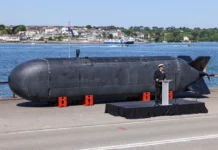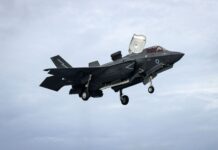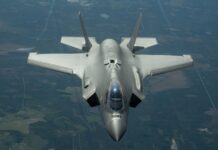“The F-35 is the best fast jet the UK has ever had – but the Ministry of Defence’s (MoD’s) cost-cutting approach has caused significant problems in its use,” the UK House of Commons’ Public Accounts Committee (PAC) has concluded.
In a report published on 31 October 2025, the PAC lays out a pattern of short-term decision-making from the UK MoD that has affected the F-35’s capability, availability to fly and value for money.
Specifically, the PAC cites a number of mis-steps. Firstly it states that a delayed investment in the facility that assesses the F-35’s stealth capability, which in the short term saved GBP 82 million (EUR 93.5 million) by 2024-25, will have ended up costing the MoD GBP 16 million more than that by 2031-32 due to inflation.
Secondly, the PAC notes that in 2010 the MoD chose to delay the delivery of some aircraft to make short-term financial savings, which has reduced the number of aircraft available today: a situation exacerbated by a delay of seven aircraft by a year in 2020 for financial reasons.
Thirdly, the PAC states the delay of 809 Naval Air Squadron’s infrastructure, delivery of which the MoD decided to put off until 2029 to save money. The costs here, the PAC asserted, have now increased from GBP 56 million to a forecast GBP 154 million.
The PAC additionally noted that the UK’s F-35 programme suffers from an unacceptable shortage of engineers, posing an obstacle to the aircraft flying more often.
“While this shortage reflects wider challenges across the armed forces, the MoD worsened the situation for F-35s by miscalculating how many engineers would be needed per plane, through failing to take into account staff taking leave and performing other tasks,” the PAC report stated.
Although the PAC acknowledged that this mistake has now been identified and new funding provided, the committee pointed out this this issue “will still take several years to resolve”.
The PAC also questioned the UK’s decision to acquire conventional take-off and landing F-35As in addition to the UK’s current fleet of short take-off and landing (STOVL) F-35Bs to perform the NATO nuclear mission.
“Becoming certified for the NATO nuclear mission will add new requirements to training, personnel and possibly infrastructure, but discussions in this area are at an early stage, and no indication of forecast costs has been provided by MoD,” the PAC stated.
While the UK originally had a programme of record for 138 F-35Bs, in March 2021 this was revised, with a UK Defence Command paper only stating that the fleet size would be increased beyond the 48 aircraft currently on order. As of August 2025, 40 F-35Bs had been delivered, with the remainder expected to be delivered by the end of 2025.
However, on 24 June 2025 the UK MoD announced that 12 F-35As would be procured to contribute to NATO’s Dual-Capable Aircraft (DCA) nuclear mission.
The PAC report also highlighted substandard accommodation at RAF Marham: the UK F-35 fleet’s main operating base.
“The MoD accepted to the PAC’s inquiry that Marham’s living quarters are currently not good enough, with frontline personnel revealing that it is shabby, sometimes lacking hot water, and lacking bus access to a local town,” the PAC noted.
Sir Geoffrey Clifton-Brown MP, the PAC’s chairman, was quoting in a UK government press release on 31 October as stating, “Making short-term cost decisions is famously inadvisable if you’re a homeowner with a leaky roof, let alone if one is running a complex fighter jet programme – and yet such decisions have been rife in the management of the F-35.
“During our inquiry, the MoD told us that they viewed these kinds of decisions costing the taxpayer many millions more in the long term than the money saved in the short term as a “conventional consequence” of budget management. This is exactly the sort of attitude that our Committee exists to challenge.”
Clifton-Brown further stated, “There are basic lessons here that MoD has been worryingly slow to learn. Its appraisal of the F-35’s whole-life cost is unrealistic, which it currently gives as at almost GBP 57 billion through to 2069. But this figure does not include costs for personnel, fuel and infrastructure, which the MoD will struggle to operate a successful programme without. Moreover, the MoD is due to declare the jet’s full operating capability, despite unresolved personnel shortages.”
In terms of the jet’s tactical capability, Clifton-Brown noted that UK F-35s “will also not have the ability to attack ground targets from a safe distance until the early 2030s – the aspect of the F-35’s capability which the Chief of the Defence Staff told us worried him most”.












![How much ‘growth’ is there still in 4th-Gen fighters? A German Air Force Eurofighter Typhoon flies through the sky during the Exercise BAANA 2024, Ranua, Finland, on 4 September 2024. [US Army/Sgt Scyrrus Corregidor]](https://euro-sd.com/wp-content/uploads/2025/06/Eurofighter-Typhoon-BAANA_US-ArmySgt-Scyrrus-Corregidor-Kopie-218x150.jpg)
![US air dominance: The story so far President Trump, the 47th President, said that the USAF’s first sixth generation fighter would be known as the F-47, insisting that: “The generals picked a title, and it's a beautiful number…” Trump also noted that “an experimental version of the plane has secretly been flying for almost five years.” [USAF]](https://euro-sd.com/wp-content/uploads/2025/06/2-F-47-8928628-1-Kopie-218x150.jpg)